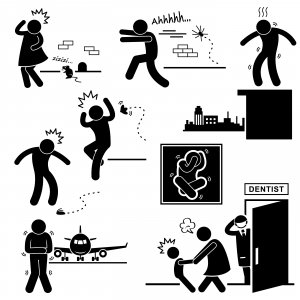Category file: Psychologist in Madrid
Loss, to make room for the new
Stephen Grosz, a British psychoanalyst well-known to many psychologists in Madrid who have read his articles in El País, was recently interviewed by Tim Black on his book The Examined Life.
It is fairly unusual for psychoanalysts to write books or articles in such a way that the discipline may be understood by those unfamiliar with the field, and Grosz has done so remarkably well. The success of his book, and how well received it has been, attests to this fact.
In the interview, Grosz touches on his intellectual background and on the relevancy of Freudian thought today. He seeks to avoid pseudo-knowledgeable psychoanalytical jargon and aims to express what is essential to Freud’s discoveries –– notably a method of listening, without preconceived ideas, to what patients say in order to afford them a truthful view of their inner selves.
One of the central ideas of The Examined Life, and Grosz’ interview, is the importance of developmental arrest –– how not being able to lose something can freeze an individual in a state that doesn’t allow them to grow, develop deeper relationships, or gain new capacities. As Grosz puts it: “It’s only by letting go that you will make space for the next phase”.
Through the use of the evocative metaphor of haunting he describes how psychoanalytic treatment summons up, in a way, the ghosts in the patient’s mind. Ghosts that have never had a setting where they could be confronted, and that haunt the patient’s life with their uncomfortable presence.
Psychoanalysis offers them that setting, calls them into the awareness, and faces them squarely. Only then can they be put to rest.
Read Grosz' full interview.
Psychology and treatment of self-destructive behaviour
Self-destructive behaviour is, at first glance, amongst the most enigmatic and counterintuitive emotional disorders. How is it possible that someone would wish to harm themselves?
It seems to run directly against what appears to be everyone’s apparently obvious wish to seek out pleasure and happiness. There’s something disturbing about wishing to damage oneself, not protecting oneself, to seek out suffering. People who discover this trait in themselves are often deeply troubled by it.
And yet, if we take a step back for a minute, sooner or later we will observe that self-destructive behaviour is far from being unusual.
Indeed, it does sometimes present itself in very clear and recognisable forms, where the wish to destroy oneself is manifest and conscious (or almost): self-mutilation, certain drug-abuses, or exposing oneself willingly to another person’s violence, are examples of this.
However, these manifestations, so blatantly recognisable, are not by any means the most common forms of self-destructive behaviour. Far more common are all the subtle and compulsive forms of self-sabotage, of which the individual has no awareness whatsoever, and that effectively attack her or his wellbeing.
To be continually self-derogatory, seeking humiliation without realising it, approaching everything from a negative standpoint, going through mysterious and repetitive failures, insidiously (and firmly) hanging onto pernicious situations, or constantly finding oneself in the position of a victim are among the many ways that can be used to harm oneself.
We should also note that, from a larger point of view, some ideologies (be they religious, political, or other) derive a feeling of validation ––often of moral superiority–– on the experience of suffering. They thus attract individual who seek intellectual justification for their unconscious self-destructive needs.
If we investigate these situations in depth, we will first discover the relatively transparent incapability of allowing oneself to be simply happy. But we will also find, and much less obviously so, the secret pleasure that is obtained from suffering –– secret because it is unacceptable to our consciousness.
How does this come to be?
Understanding and treating psychological inhibitions
Inhibition expresses itself in many ways. It is probably one of the most common clinical symptoms psychologists come across, as well as one of the most frequent limitations with which some individuals, who believe that they are relatively free from difficulties, live with unawares.
Inhibition consists in an incapacity to freely express a wish or a natural ability; the individual is diminished by the inhibition and cannot fully develop himself or herself. This generally entails a significant limitation in the enjoyment of their life.
Inhibition frequently manifests itself in sexuality, sometimes annulling it completely, as well as in the fear of facing conflicts, leaving the person defenceless. It is not unusual for intellect, attention and/or memory to be hindered by it, which can obstruct educational and professional development.
It is sometimes linked to food, drastically reducing the capacity to nourish oneself; it can appear when one has to speak in public, leaving the person mute and confused; it is also well known amongst people who play sports and who can suddenly find themselves incapable of competing… The list is potentially endless.
Where does it come from?
What’s the difference between mourning, depression, melancholia and mania?
Mourning, depression and melancholia are often confused with one another, and mania is, for the most part, quite unknown. The term bipolar disorder, meanwhile, has become prevalent in everyday language whereas its clinical frequency has not changed.
They are all linked to a feeling of loss and, apart from mourning ––which is an entirely normal process that isn’t pathological–– they all belong to what are called mood disorders, those that affect the individual’s affective state, either by lowering it or heightening it.
Since there have been many questions about the subject from people in Madrid, let’s review what the differences are briefly.
Mourning:
Mourning is characterised by a state of sadness and apathy, often accompanied by insomnia and fatigue, that follow a conscious emotional loss. A loss that can be that of a loved one, a place, an activity, or even certain intellectual ideals.
Someone who is in mourning is fully aware of what they have lost; the acknowledgment of the loss leads them to slowly give up all the satisfactions, wishes and hopes that were tied to what has been lost –– hence the feeling of an impoverished world, and profound sadness. An important source of vitality, motivation and interest in their life is gone.
Mourning is not linear: it can be very intense, then disappear, come back at an unexpected time, or be absent at a moment when one would expect it. Although mourning gradually fades with time, it is not unusual for it to last several years if the loss has been that of someone or something deeply meaningful to the person.
Someone in mourning does not need psychotherapy or medication, they need time to reorganise their inner emotional landscape, and to be surrounded by understanding people. If, however, there is no modification in the sadness and the apathy over time then we talk about pathological mourning, which is a form of depression.
Who can become a psychoanalyst?
In Spain, as in most of the Western world, current legislation requires that those who wish to study psychoanalysis must previously have undertaken studies in psychiatry or clinical psychology.
These preceding studies guarantee a solid enough grounding in psychopathology, differential diagnosis, brain functioning, psychopharmacology, research methods, treatment options and social psychology that are essential for clinical practice.
However, those studies are not enough to be a psychoanalyst. There are certain personality traits, of those who wish to undergo further training in order to become psychoanalysts, that must be present in order for that wish to become a reality. These traits are not necessarily fully consolidated at the beginning of an analyst’s training, but there has to be at least a core that can be developed.
Those who wish to train in psychoanalysis in Madrid, in the Asociación Psicoanalítica de Madrid, will go through interviews where these qualities will be assessed, as well as the depth of self-knowledge acquired through personal analysis.
What are they then?
Emotional and intellectual honesty:
Every psychoanalysis and psychoanalytic psychotherapy rests on the quest for finding the patient’s inner truth, whatever it may be. This comes with a requirement of honesty on the patient’s part, but also on the analyst’s. Due to the sensitive material that they will work with and the trust it requires, the analyst must be willing to recognize that he is not infallible and can make mistakes, and he must also be willing to face whatever may arise during the treatment –– analysis is not an ascetic intellectual exercise and strong emotions will most likely appear at some time.
Who benefits the most from psychoanalysis and psychoanalytic psychotherapy?
There are currently many schools of psychotherapy –– such as psychoanalysis, cognitive-behavioural therapy, systemic therapy, humanistic therapies, etc.–– that are based on divergent theoretical foundations, and offer different treatment modalities.
Although historically each one of these schools has claimed, or sometimes still claims in certain cases, that it is valid for all those who seek psychological help, empirical evidence and the combined years of experience of many practitioners show us that this is not a verified fact.
In addition to the specific expectations of the people looking for assistance, their individual personalities will lead them to be more receptive to one kind of help than to another. The most noteworthy differences between people when it comes to choosing a psychotherapeutic treatment will manifest through their tolerance to frustration, where they locate their problems, and their degree of autonomy.
When it comes to psychoanalysis and psychoanalytic psychotherapy, there are certain personality dispositions ––that do not necessarily express themselves in all situations, but are nevertheless central to the person’s psychological makeup–– without which it is difficult for someone to be able to benefit greatly from this type of treatment.
What are they?
Let’s begin with the fact that psychoanalysis and psychoanalytic psychotherapy rest on some fundamental principals, mainly that:
Phobias: diagnosis, etiology and treatment
The diagnosis of a phobia is usually fairly clear. A phobia is any irrational fear of objects, animals, situations or spaces that are not objectively dangerous.
One is afraid of something objectively dangerous ––a lion, for instance–– but one has a phobia of something objectively harmless, a mouse. The phobia does not come from the phobic object in itself but from what that object stirs up in the mind of the individual that suffers from the phobia.
Phobias are a very effective way for the psychic apparatus to get rid of the inner anxiety from which the subject suffers. Instead of feeling that the anxiety and the danger are within, the phobia allows the subject to locate the source of anxiety outside, where it can be avoided.
For instance: an individual who is very afraid of her own aggressiveness may develop a phobia of dogs (onto which she can attribute the idea of aggressiveness). Then she can avoid dogs and, by doing so, be free of anxiety. The fear of herself has become the fear of something else that can be avoided. Needless to say, all of this happens unconsciously, there is no conscious intentionality in the creation of a phobic symptom.
Precisely because of the fact that phobias allow the individual to locate the source of danger on the outside, many people can live with their phobias without great difficulties since they simply avoid their phobic object, and thus avoid anxiety.
However, the situation becomes more complicated when avoiding the phobic object starts to severely restrict the individual’s freedom. It is not uncommon in certain cases for phobic objects to multiply, progressively invading and limiting the subject’s life more and more.
The first meeting with a psychologist
The reasons for which people consult a psychologist are as varied as the people themselves, but they all have one thing in common: the person who consults about her/his emotional problems cannot solve them on his/her own.
In all likelihood, this person will have tried several times to find a solution, be it by exercising strict self-discipline, be it through talking to people close to him/her, be it through reading self-help books; however, despite all these sincere efforts, unfortunately the problems continue.
This inability to resolve the difficulties on his/her own is due to the fact that they are of unconscious origin and they are therefore not available to the individual’s understanding. We all have an idea of who we are, but sometimes the gap between who we think we are and who we really are is so great that it produces incomprehensible symptoms.
When we know what the matter with us is it is relatively easy to take whatever measures may be necessary in order to change the situation. However, when we don’t know ––and we suffer from depression, anxiety or sexual difficulties, amongst others–– we become, in a way, victims of ourselves, without any control or capacity to modify what is making us suffer. An unknown part of us harries us like an invisible shadow from which we cannot escape. Nina Coltart, a fine British psychoanalyst with a penchant for literature, called it “the beast that lurches in the dark”.
It is true that we often have an idea, sometimes more precise, sometimes less so, of where these problems may come from but, if we cannot resolve them on our own, we can be sure that that we’re missing essential elements, fundamentally emotional, that would give real and felt meaning to the suffering. The goal of a psychoanalytically oriented psychological treatment it to shed light on the unknown, make it tangible and thus modifiable.
Treatment of psychological trauma
What is psychological trauma?
Psychological trauma is the result of a painful excess of emotional intensity that shatters the mental functioning of an adult, or that severely distorts the development of a child’s mental functioning.
The most common psychological traumata are generally due to: a) a rupture in the basic feeling of safety; b) a lack of necessary human interaction; c) being the object of excessive or inadequate manifestations of aggressiveness / sexuality.
Though we usually associate the word trauma to something massive and obvious, it is important to note that it can equally result from something small and accumulative.
In the same way that the physiological tissues of the body can handle a certain force of impact without deteriorating beyond their capacity to recover, the mental tissue can withstand a certain quantity of emotional impact without being damaged beyond its capacity to heal. However, beyond a certain threshold, the impact is too strong, and it negatively modifies the physiological and mental tissues permanently.
From this moment onwards, if treatment is not applied, the damage will tend to become chronic and will compromise the rest of the person’s functioning. In the same way that a broken leg, that has not been adequately treated, will seriously limit the individual’s movement ––as well as causing muscular unbalances, and hip and spine misalignments––, untreated psychological trauma will leave the person “limping” emotionally, as well as creating a whole series of compensatory behaviours that will paradoxically worsen the original state.
How does psychological trauma affect us?
Without going into great depths that would be out of place here, we can understand the mind as a processor of stimuli (internal and external) that uses them to maintain itself and to evolve. This processor also needs to discharge the stimuli that exceed its capacity to use them for growth, and this discharging is frequently associated with pleasure (e.g. creative and physical activity, sexuality, etc.) At a neuronal level, every stimulus creates activation in the neurons that has to be processed, absorbed or discharged one way or the other.
A brief psychology of self-esteem
What is self-esteem?
Self-esteem is just a technical word to refer to liking oneself. If we investigate this idea a little further, we can see that self-esteem comes from the capacity to like oneself in one’s true measure: to be able to identify one’s strong points and one’s weak points, and to be able to be reasonably proud of the former and tolerant with the latter. This means, therefore, being able to like what one really is, in a stable way.
Self-esteem also comes from being able to reach one’s goals, which need to be possible and motivating, and not so unreachable that they become crushing. In order to be able to feel comfortable with oneself, the distance between what one is and what one would like to be must be stimulating, not insurmountable. This is where phrases such as “where to put the bar” or be “up to the task” come from. If the bar is too high, it’s a source of constant frustration, if it’s too low, boredom takes over.
When one’s self-esteem is damaged, one can’t accept oneself, nor can one like oneself the way one really is. One will also tend to judge oneself very harshly, which will lower one’s self-esteem even more and will result in the creation of the vicious circle in which so many people who suffer from self-esteem difficulties find themselves in.
What are the sources of self-esteem?
Self-esteem has four different sources that follow each other in development and that combine once the person has reached adulthood.
The first source is the most uncertain of all since we do not have the means to observe it empirically; nevertheless, this source is hypothesized from the observation of the most primitive fantasies in adult patients. We consider that in every small baby there is a stage of self-satisfaction and feeling of absolute completeness in which the baby feels perfectly contented with herself and finds herself submerged in a state of undifferentiated bliss that she believes to be her creation. This state cannot be maintained, of course, without the very active participation of a primary caregiver that provides a sufficiently satisfying context for the baby, but she doesn’t really realise it at this stage.










